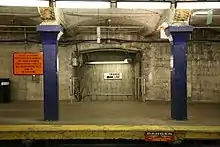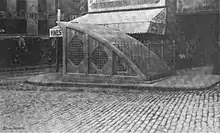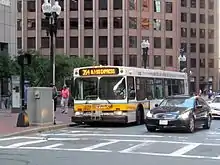State station
State station (also called State Street station) is a subway station in Boston, Massachusetts. Located in downtown Boston, State is the transfer point between the MBTA Orange Line and the Blue Line, and one of four "hub stations" on the MBTA subway system.
State | ||||||||||||||||
|---|---|---|---|---|---|---|---|---|---|---|---|---|---|---|---|---|
 Blue Line platforms at State station in August 2018 | ||||||||||||||||
| Location | 200 Washington Street Boston, Massachusetts | |||||||||||||||
| Coordinates | 42.3587°N 71.0578°W | |||||||||||||||
| Line(s) | East Boston Tunnel Washington Street Tunnel | |||||||||||||||
| Platforms | 4 side platforms (2 on each level) | |||||||||||||||
| Tracks | 4 (2 on each level) | |||||||||||||||
| Connections | ||||||||||||||||
| Construction | ||||||||||||||||
| Platform levels | 2 | |||||||||||||||
| Disabled access | Yes | |||||||||||||||
| History | ||||||||||||||||
| Opened | December 30, 1904 (Blue Line) November 30, 1908 (Orange Line) | |||||||||||||||
| Rebuilt | April 18-21, 1924 (Blue Line) April 26, 2011 | |||||||||||||||
| Previous names | Devonshire (1904–1967) Milk/State (1908–1967) State/Citizens Bank (1997–2000) State/Aquarium (2004) | |||||||||||||||
| Passengers | ||||||||||||||||
| FY2019 | 12,928 (weekday average boardings)[1] | |||||||||||||||
| Services | ||||||||||||||||
| ||||||||||||||||
What later became the Blue Line platforms of State station were opened in 1904, making it the oldest surviving MBTA rapid transit (heavy rail) station (the Tremont Street subway, opened in 1897, serves only light rail streetcars). After an extensive renovation which was completed in 2011, State is fully accessible.
History
East Boston Tunnel

The Blue Line section of the station was built along with the rest of the East Boston Tunnel in the first years of the 20th century and opened on December 30, 1904, serving streetcars running from downtown to East Boston.[2] An unusual aspect of State Street station is the entrance built directly into one of Boston's best-known historic sites, the Old Massachusetts State House. The East Boston Tunnel station was originally known as Devonshire after the street which the Old State House is located on. The station is the only remaining station on the tunnel opened in 1904.
The East Boston Tunnel was originally planned to be operated with high-floor metro rolling stock and connected to the then-planned Cambridge Elevated line. When that plan was dropped in 1903 due to a disagreement between the BTC and the BERy, the stations were built with low platforms.[3]:19 Large bi-loading streetcars (with high floors but capable of loading from low platforms), which incorporated many attributes from metro cars used on the Main Line El, began use in 1905.[3]:118–119[4]:14 However, neither these nor the large center-entrance cars introduced in 1917 (which were designed for multiple unit operation) could fully handle the crowds.[4]:43
In 1921, the Boston Transit Department (BTD) - the successor to the BTC - began work at Maverick Square to convert the East Boston Tunnel to high-floor metro trains.[5] The next year, the BTD board approved the construction of high-level platforms at Atlantic Avenue, Devonshire, Scollay Under, and Bowdoin.[6] Construction of concrete high-level platforms 40 inches (1.0 m) above the rails at Devonshire began in December 1923 or January 1924. A section of low-level platform was left to serve streetcars during construction.[7] The station was also extended by 30 feet (9.1 m) to accommodate the new trains, with work completed on March 1, 1924.[6][8] Over the weekend of April 18–21, 1924, the East Boston Tunnel was converted to high-floor metro stock.[9] Temporary wooden platform sections were put in place to allow service to begin on April 21, with the permanent concrete sections completed by July 12.[8] The edges of the original low platforms can still be seen under the high platforms.[10]
On March 31, 1937, the BERy opened an entrance from the Exchange Building lobby to the eastbound platform.[11] The entrance was closed around 1981 as the building was modified for construction of Exchange Place.
Washington Street Tunnel

The Washington Street Tunnel opened on November 30, 1908 to Main Line elevated trains running between Forest Hills and Sullivan Square.[2] As with the other stations in the tunnel; the two platforms were treated as completely separate stations. The northbound platform was known as State since its main entrance was at the cross street of State Street, while the southbound platform was similarly Milk Street after its entrance from Milk Street. (The station pair was designated on some maps as Milk/State).[2]
MBTA era

After taking over operations in 1964, the Massachusetts Bay Transportation Authority (MBTA) began rebranding efforts. The East Boston Tunnel/Revere Extension and Main Line El/Washington Street Tunnel routes were renamed as the Blue Line and Orange Line on August 25, 1965. On January 25, 1967, the separate station names of Devonshire and Milk/State were changed to State.[2] In 1971, the MBTA and Institute of Contemporary Art, Boston held a competition called "Design in Transit", with the winning work to be placed in the passageway to the southbound Orange Line platform. It attracted over 300 entries, many of which were criticized for being inappropriate for the setting: "spooky shadow play" that would scare riders already in a nervous atmosphere, and audio works that would add to the cacophony of the busy station.[12] The winning work by Robert V. Kennedy had swatches of bright rainbow colors with timed lighting; it was installed in 1972.[13]
That year, the agency received a federal grant that funded two-thirds of a $14.3 million modernization program for downtown stations.[14] As part of that project, the MBTA investigated the feasibility of connecting Essex, Park Street, Washington, and State with pedestrian tunnels.[15] The MBTA proposed to make the City Hall (Adams Square) headhouse exit-only during budget cuts in 1981.[16]

In the mid-1980s, the MBTA spent $80 million to extend the platforms of seven Red Line and three Orange Line stations to allow the use of six-car trains.[17] On October 16, 1985, the MBTA awarded a $5.03 million contact for the Orange Line work at State.[18] Construction at State began that year and was completed in 1987.[2][19] The project extended both Orange Line platforms (the shell of the northbound extension had been constructed during an earlier modernization project), and rebuilt the Milk Street entrance.[2][20] Elevators were added from Milk Street to the southbound platform, and between the Orange Line platforms; this made both Orange Line platforms and the eastbound Blue Line platform accessible.[21] (Until renovations at Haymarket and North Station in 2001, State was the closest accessible subway station to the North Station commuter rail terminal.)[22] Six-car trains entered service on August 18, 1987, shortly after the platform extensions were complete.[2]
From 1997 to 2000, State was renamed State/Citizens Bank in a $500,000 corporate sponsorship from Citizens Bank, who had recently moved to the area, and hoped to eventually have the name changed to simply Citizens Bank Plaza.[23] The sponsorship failed and the name reverted to State. During the renovation of Aquarium station, during which that station was closed, State was renamed temporarily State/Aquarium from October 14, 2000 to October 29, 2001.[2]
An extensive renovation of State began in November 2004.[24] The project added accessible Blue Line entrances at 53 State and 60 State, extended the Blue Line platforms for 6-car trains, and added a ramp between the inbound Blue Line platform and the northbound Orange Line platform.[25] The MBTA initially expected the work to be completed in 2007 at a cost of $38 million.[26] However, several factors prolonged the project and increased its cost. Keeping the station open during extensive underground construction proved more difficult than expected; support structures had to be drilled through centuries-old foundations and seawalls.[26][27] The MBTA settled a lawsuit over systemwide accessibility issues in 2006, which necessitated changes to the station design.[26] The change from token payment to the Charliecard system required closing the Blue Line level of the station from June 24 to July 1.[2][28] The 6-year-long reconstruction of the station was substantially completed in 2011, with a ribbon-cutting ceremony on May 26.[26][25] The final project cost was $68.3 million, of which about $12 million was design and land acquisition.[25][26][29] In October 2011, a 1904 plaque that marked the completion of the East Boston Tunnel was reinstalled in the station.[30]
On June 24, 2019, the MBTA Board awarded a $29.7 million, 16-month contract for full cleaning, wayfinding signage replacement, and other improvements at North Station, Haymarket, State, and Downtown Crossing stations.[31] As of May 2020, that work is expected to be complete by the end of 2020.[32]
Station layout

State is unique among Orange Line stations as it was built on two levels to fit under the narrow section of Washington Street while crossing the East Boston Tunnel. The southbound side platform is above the northbound track and furthermore staggered considerably south of the northbound side platform. The southbound platform is connected to the rest of the station by a lengthy pedestrian passageway, originally known as "the speedway".[33] The Blue Line has two side platforms under State Street and the Old State House.
The station's headhouses are located between Government Center and the Financial District. State station has six entrances spread out over nearly 1,000 feet (300 m); after consolidation and reconstruction by the MBTA, all entrances serve both lines in all directions. One entrance is built into the basement of the Old State House and four into commercial buildings. The northernmost entrance, which is accessed from an unmarked stairwell under 28 State Street on Government Center Plaza, was originally constructed to serve Adams Square but now primarily serves Boston City Hall.[33]
Three entrances are fully accessible with elevators to platform level: Old South Meeting House (Washington Street at Milk Street), 53 State Street, and 60 State Street. The other three entrances - Old State House (State Street at Devonshire Street), Devonshire Street at Water Street, and Government Center Plaza - are not accessible.[34] An additional elevator connects the northbound Orange Line platform with the eastbound Blue Line platform and southbound Orange Line platform, while an accessible ramp connects the westbound Blue Line and northbound Orange Line platforms. In May 2020, the MBTA awarded a design contract for accessibility renovations at State and Chinatown. The work at State includes a new elevator at the City Hall entrance, replacements of two existing elevators, and renovation of the Milk Street entrance.[35]
Public art
The station has several works of public art:
- The passageway to the southbound Orange Line platform was painted with rainbow colors by Robert V. Kennedy in March 1972. The painting and corresponding timed lighting (no longer in use) cost $9,000.[13][36][37] Kennedy won the 1971 competition to design artwork for the station.[38]
- Polychrome painted star, a 12-by-40-foot (3.7 m × 12.2 m) 1975 enamel-on-porcelain mural by Toshihiro Katayama, is located in the passage to the eastbound Blue Line platform.[39][40]
- A 1987 black steel gate by Albert Paley is located next to the Old South Meeting House headhouse.[41][40]
Bus connections

State is served by eight MBTA bus routes: three local routes, three early morning special routes (191-193), and two express routes (352, 354).[34]
- 4: North Station–Tide Street
- 92: Sullivan Square station–Downtown Boston via Main Street
- 93: Sullivan Square station–Downtown Boston via Bunker Hill Street
- 191: Mattapan station–Haymarket station
- 192: Cleary Square–Haymarket station
- 193: Watertown Yard–Haymarket station
- 352: Burlington–State Street, Boston
- 354: Woburn–State Street, Boston
State is also the closest Blue Line stop to the bus hub at Downtown Crossing, which is three blocks from the Old South Meeting House entrance.[34]
References
- "A Guide to Ridership Data". MassDOT/MBTA Office of Performance Management and Innovation. June 22, 2020. p. 6.
- Belcher, Jonathan. "Changes to Transit Service in the MBTA district" (PDF). NETransit.
- Cheney, Frank (2003). Boston's Blue Line. Arcadia Publishing. ISBN 9780738535760.
- Cox, Harold E.; Cummings, O. R. (1963). Surface cars of Boston, 1903-1963. New England Electric Railway Historical Society. hdl:2027/mdp.39015021059525.
- Annual Report of the Transit Department for the Year Ending January 31, 1922. Boston Transit Department. 1922. p. 27 – via Google Books.
- Annual Report of the Transit Department for the Year Ending January 31, 1923. Boston Transit Department. 1923. p. 3 – via Internet Archive.
- Annual Report of the Transit Department for the Year Ending January 31, 1924. Boston Transit Department. 1924. pp. 28-29 – via Internet Archive.
- Annual Report of the Transit Department for the Year Ending January 31, 1925. Boston Transit Department. 1925. pp. 35–36 – via HathiTrust.
- Cudahy, Brian J. (1972). Change at Park Street Under. Stephen Greene Press. pp. 31–32. ISBN 0828901732. LCCN 72081531.
- Moskowitz, Eric (May 29, 2011). "Among the new renovations, Blue Line's past appears at State Street". Boston Globe.
- "Subway Entrance in Exchange Building". Boston Globe. March 31, 1937. p. 16 – via Newspapers.com.

- Durso, Holly Bellocchio (June 2011). Subway Spaces as Public Places: Politics and Perceptions of Boston's T (MCP). Massachusetts Institute of Technology. p. 55. hdl:1721.1/66801.
- Eighth Annual Report. Massachusetts Bay Transportation Authority. 1972. p. 14 – via Internet Archive.
- Carr, Robert B. (July 26, 1972). "Park St. station facelift due". Boston Globe. p. 3 – via Newspapers.com.

- Plotkin, A.S. (March 1, 1974). "4 downtown MBTA stops may be linked". Boston Globe. p. 5 – via Newspapers.com.

- Massachusetts Bay Transportation Authority (February 13, 1981). "Public Hearing Notice". Boston Globe. p. 50 – via Newspapers.com.

- 1985 Annual Report. Massachusetts Bay Transportation Authority. 1985. p. 13 – via Internet Archive.
- Sanborn, George M. (1992). A Chronicle of the Boston Transit System. Massachusetts Bay Transportation Authority – via Massachusetts Institute of Technology.
- Tran Systems and Planners Collaborative (August 24, 2007). "Evaluation of MBTA Paratransit and Accessible Fixed Route Transit Services: Final Report" (PDF). Massachusetts Bay Transportation Authority.
- 1986 Annual Report. Massachusetts Bay Transportation Authority. 1986. p. 23 – via Internet Archive.
- MBTA : ACCESS; The Guide to Accessible Services and Facilities. Massachusetts Bay Transportation Authority. June 1992. p. 12 – via Internet Archive.
- Ackerman, Jerry (March 8, 1989). "T pressured to open all routes to disabled". Boston Globe. pp. 1, 16 – via Newspapers.com. (second page, third page)

- "Suited to a T: State Street station becomes a billboard for Citizens Bank". Boston Business Journal. December 19, 1997.
- "State Street Station Project To Begin" (Press release). Massachusetts Bay Transportation Authority. November 3, 2004. Archived from the original on December 5, 2004.
- "Patrick-Murray Administration Highlights MBTA Blue Line Modernization at State Street Station" (Press release). Massachusetts Bay Transportation Authority. May 26, 2011.
- Moskowitz, Eric (May 27, 2011). "State Street T stop has $68m new look". Boston Globe.
- "State Street MBTA Station Rehabilitation (S09CN11)". Barletta Engineering and Heavy Division. Archived from the original on February 28, 2017.
- Daniels, Mac (June 25, 2006). "Hot trains leave some riders steaming". Boston Globe. p. 30 – via Newspapers.com.

- Moskowitz, Eric (October 3, 2010). "T says State Street upgrade will finally be done next year". Boston Globe.
- Fox, Jeremy C. (October 21, 2011). "1904 plaque returns to Blue Line station". Boston Globe. Archived from the original on December 5, 2011.
- "MBTA Contract No. A01CN01: Wayfinding and Station Improvements - Four Stations (Downtown Crossing, State, Haymarket, and North Station)" (PDF). Massachusetts Bay Transportation Authority. June 24, 2019.
- Brelsford, Laura (May 26, 2020). "SWA Initiatives—May 2020" (PDF). p. 5.
- "The Stations of the Washington St. Tunnel, Boston, Mass". Engineering News: A Journal of Civil, Mechanical, Mining and Electrical Engineering. 62 (15): 369. 7 October 1909.
- "State Station Neighborhood Map" (PDF). Massachusetts Bay Transportation Authority. July 2012. Retrieved 24 May 2016.
- "Architectural and Engineering Services for Station and Accessibility Improvements" (PDF). Massachusetts Bay Transportation Authority. May 21, 2020.
- Alonso, Jessica (April 5, 1977). "Art from underground". Boston Globe. p. 20 – via Newspapers.com.

- Fripp, Bill (March 16, 1972). "In the tunnel of art". Boston Globe. p. 35 – via Newspapers.com.

- Kay, Jane Holtz (July 11, 1971). "A look at some underground art". Boston Globe. p. 186 – via Newspapers.com.

- Katayama, Toshihiro. "Works in Architectural Space".
- "On the Orange Line" (PDF). Massachusetts Bay Transportation Authority. p. 5.
- Howe, Peter J. (April 27, 1988). "MBTA hopes riders will be transported by art". Boston Globe. pp. 21, 35 – via Newspapers.com. (second page)

External links
| Wikimedia Commons has media related to State station. |
- MBTA – State
- Entrances on Google Maps Street View: Old South Meeting House, Water Street, Old State House, 60 State Street, 53 State Street